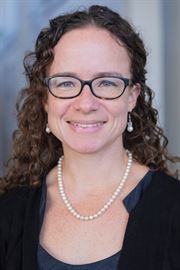Imagine pouring farm-fresh milk down the drain or crushing perfectly good eggs that could feed families. This has been the reality for farmers during the COVID-19 epidemic.
The COVID-19 epidemic has not only created a medical crisis across the country, but it has greatly crippled the food supply chain, leaving farmers without buyers and food banks without food. Civil and Environmental Engineering Professor Colleen Naughton is working to identify areas of improvement along the supply chain to make farm-to-table a reality, even during a national crisis.
Naughton’s work is explored in the second installment of UC Merced’s “Building the Future” docuseries.
Naughton studies supply chain “pinch points” — using life cycle assessments and other systems analysis to identify areas of improvement along the supply chain. Her work with UC Merced’s Center for Information Technology Research in the Interest of Society (CITRIS) aims to leverage information technology in a way that helps small farmers and disadvantaged communities and manages resources such as food, energy and water in a sustainable way for years to come.
“COVID-19 has altered our food supply chain that usually farmers plan months or even years in advance,” said Naughton, who is working on a seed grant project on adapting the food supply chain. “We’re looking at how to create more resilient and equitable systems and make those available to public policy makers and businesses to make decisions and improve the systems.”

Including interviews with local farmers, Merced County Food Bank staff, faculty and student researchers, episode two explores the impact of the food supply chain disruption locally and at large.
Many farmers are donating excess food as food bank demand soars with rising unemployment, but it is not always economically feasible for them to harvest and transport crops on top of their losses. Governments, farmers, nonprofits and consumers are all struggling to adapt to new way of life.
“If your crop is not selling, there’s nothing you can really do about it,” said Gino Pedretti, a fourth-generation rancher in Merced County. “As farmers we try to be resilient and if we don’t plant a crop, we don’t make any money, so we’re just planting a crop and hoping and praying at night that the pandemic ends and that commodity prices will recover.”
More people are seeking assistance from food banks. Since the pandemic hit in March, the Merced County Food Bank has seen an increase from roughly 125 people per day to more than 1,200, said Executive Director Bill Gibbs.
Typically, food banks share excess donations with each other. Without excess food to share and retailers buying up items on the wholesale market, food banks have been forced to compete in the retail market with the very companies that usually donate food.
“It made it very complicated to source food, because everybody — all those big donors like Costco, Wal-Mart, Target, Safeway — were competing for the same limited supply,” Gibbs said.
Watch the latest episode of the Building the Future docuseries to learn about the impact of the coronavirus on the food supply chain and how UC Merced researchers’ work aims to help.